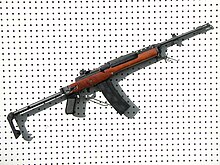Blog Archive
| Ruger Mini-14 | |
|---|---|
 The Mini-14 | |
| Type | Carbine |
| Place of origin | |
| Production history | |
| Designer | L. James Sullivan, William B. Ruger |
| Designed | 1967–1973 |
| Manufacturer | Sturm, Ruger & Company, Inc. |
| Produced | 1973–present |
| Variants | Ranch Rifle, Mini Thirty, Mini-6.8, AC-556, GB, Target |
| Specifications | |
| Weight | 6 lb 6oz (2.90 kg) |
| Length | 37.25 in (946 mm) |
| Barrel length | 18.50 in (470 mm) 13 in (330 mm) (AC-556) |
| | |
| Cartridge | .223 Remington/5.56x45mm 7.62x39mm 6.8 mm Remington SPC .222 Remington |
| Action | Gas-operated, rotating bolt |
| Rate of fire | Semi-automatic or Selective fire (AC-556) |
| Muzzle velocity | 3100 ft/s (945 m/s) |
| Feed system | 5, 10, 20, and 30-rd factory box magazine |
Ruger also offers a selective fire variant of the Mini-14, the AC-556, to police and military customers. AC-556 models have a slightly longer receiver (shared with early production "series 180" models) to allow for full automatic operation. These models are also available with features such as short barrels and bayonet lugs. The Mini-14GB model is a semi-automatic variant for police and military sale with the additional factory options of a short barrel, folding paratrooper stock, flash hider and a bayonet lug.[2]
Design
Designed by L. James Sullivan[3] and William B. Ruger, the rifle employs an investment cast, heat-treated receiver and a version of the Garand locking mechanism with a self-cleaning, fixed-piston gas system. The Mini-14 product page [4] describes it as a “simple, rugged Garand-style breechbolt locking system, with a fixed-piston gas system and self-cleaning, moving gas cylinder.”[1][5] The rifle is available in stainless or blued finish with hardwood, synthetic, or laminated stocks and an 18.5-inch (470 mm) barrel. Target models are currently available only in .223 Remington are not chambered to fire the 5.56x45mm NATO round. They also come with a 22-inch (560 mm) heavy barrel and either a laminated wood or Hogue overmolded synthetic stock.[6] Most Mini-14s have a classic sporter appearance, in contrast to comparable autoloading rifles such as the AK-47 and M16 rifle.Production versions
Initial rifles were produced with a complex, exposed bolt hold open device with no button for manual engagement. Stocks were somewhat angular and heat shields were made of wood. These rifles, with serial number prefixes before 181, were tooled and redesigned with a new stock, new bolt hold-open mechanism, and other small changes.In 2003, Ruger again overhauled the design and the production process to improve accuracy and update the styling while at the same time reducing production costs. The new models, marketed as Ranch Rifles, are based on the previous Ranch models, with integral scope bases. These new models use a modified gas system designed to reduce barrel vibration, and new iron sights. These changes combined with tighter tolerances result in greater potential accuracy.[5]
History
The Mini-14 was first introduced in 1974 by Ruger. Mini-14 is derived from the military M14 rifle implying a miniature version of the M14. Ruger used the M14 as a model for the new rifle while incorporating numerous innovations and cost-saving engineering changes. The Mini-14 proved popular with small-game hunters, ranchers, law enforcement, security personnel and target shooters. It competes with other rifles like the comparably-priced Kel-Tec SU-16 and numerous inexpensive AR-15 variants.Variants
The rear sight on standard models was an aperture sight with large protective wings, and there were no integral scope bases. The "Ranch Rifle" variant has scope bases integrated into the receiver, and an ejector that ejects the spent cartridge case at a lower angle to avoid hitting a low-mounted scope. The original Ranch Rifle rear sight was a folding-type aperture, which would fit under a scope.
Ruger made design alterations to the Mini-14 in 2005 altering the receiver, rear and front sights. All new Mini-14s are built with integral scope bases, non-folding ghost ring aperture rear sight and a winged front sight similar to that used on the Ruger Police Carbine.
In 2008 Ruger introduced a National Rifle Association model, with a shorter 16.25-inch (413 mm) barrel, polymer stock and two 20-round magazines.[8]
AC-556
The AC-556 is a selective-fire version of the Mini-14 marketed for military and law enforcement use. The design incorporates a selector on the right/rear of the receiver to select either semi-automatic, 3-round burst, or full-automatic fire modes; the manual safety at the front of the trigger guard operates the same as a standard Mini-14. The front sight is winged and incorporates a bayonet lug. The 13-inch (330 mm) or 18-inch (460 mm) barrel incorporates a flash suppressor. A folding stock was used on the AC-556F and AC-556K. The rifle came equipped with 20-round magazines and a 30-round version was available for a time. The AC-556 is currently produced, marketed and sold both in the United States and abroad.Other calibers
Some early Mini-14 rifles were chambered in the .222 Remington cartridge. Since the .223 Remington is dimensionally equivalent to the 5.56x45mm, civilian firearms chambered in that caliber are highly restricted in countries that restrict or prohibit firearms that chamber military cartridges (such as Mexico). By chambering the Mini-14 in the similar but not interchangeable .222 Remington caliber, the Mini-14 could be sold in those countries.[9]In 1987, Ruger began production of the Mini Thirty. The Mini Thirty is chambered for the Russian 7.62x39mm cartridge, used in the SKS and AK-47, as many states prohibit hunting of deer with calibers smaller than 6 mm (.243 in). The 7.62x39 mm has similar ballistics to the well-known .30-30 Winchester. The Mini Thirty was only available as a Ranch Rifle, with integral scope base. Current production Mini Thirtys are similar to Mini-14's except for caliber.
In 2007, Ruger announced the Mini-6.8 utilizing the commercial 6.8 mm Remington SPC cartridge that has been growing steadily in popularity.
A larger version of the Mini-14, called the XGI, was developed by Ruger in .308 Winchester and .243 Winchester. Although it was advertised in 1985, it never entered production due to continued accuracy and functioning probl
ems.

Label
- Alkitab (5)
- anime (14)
- Arti nama (3)
- Automotif (138)
- Award (1)
- Bahaya (1)
- Bangunan Unik (8)
- belajar html (1)
- benda (24)
- Binatang (36)
- Biografi (81)
- Biologi (6)
- buah (12)
- cara belajar (2)
- CIA (1)
- Community (2)
- contact (1)
- Daerah (18)
- Dewa (2)
- Dijual (1)
- Download software (5)
- drift (1)
- Ekonomi (1)
- FBI (1)
- film (33)
- Fisika (11)
- Game (37)
- ganti kusor blog (1)
- Geografi (27)
- hacker (7)
- Hewan Punah (5)
- Ilmu (48)
- ilmu Beladiri (4)
- Istilah (5)
- kata kata bijak (2)
- kata2 bijak (1)
- Kecepatan (14)
- kimia (1)
- kisah nyata (6)
- Komputer (7)
- Kristen (4)
- kuno (6)
- LAPD (1)
- link (2)
- lirik lagu (3)
- membuat virus (1)
- membuat virus melalui notepad (1)
- membuat virus via notepad (1)
- Misteri (67)
- Misteri dunia (51)
- Mitos (10)
- NASA (88)
- negara (5)
- Organisasi (2)
- Parkour (1)
- Pelajaran (1)
- Perjalanan (1)
- Perkembangan (2)
- petshop (9)
- petugas (1)
- PKN (3)
- pohon (5)
- Puisi (1)
- pulau (9)
- Rahasia (1)
- rubic (2)
- Saion (1)
- sastra (3)
- sejarah (29)
- Senjata (73)
- situs populer (7)
- Sniper (1)
- tata surya (27)
- Teknik (15)
- telepati (1)
- Tenga dalam (1)
- the power of kepepet (1)
- The Three Kingdom (8)
- TIps Binatang (10)
- Tips blogger (4)
- tradisi (9)
- tragedi (4)
- trick magic (2)
- Tumbuhan (1)
- UFO (1)
- Yesus (2)
Loading
Tian's Fan Box
Tian on Facebook
Copyright 2010 Tian
Theme designed by Lorelei Web Design
Blogger Templates by Blogger Template Place | supported by One-4-All






0 komentar:
Posting Komentar